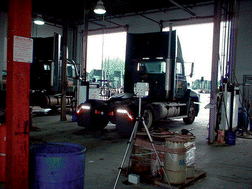Assessment of diesel particulate matter exposure in the workplace: freight terminals†
Abstract
A large study has been undertaken to assess the exposure to diesel exhaust within diesel trucking terminals. A critical component of this assessment is an analysis of the variation in carbonaceous particulate matter (PM) across trucking terminal locations; consistency in the primary sources can be effectively tracked by analyzing trends in


 Please wait while we load your content...
Please wait while we load your content...